Legend
Born to one of the most illustrious families of Burgundy, his education was provided by his parents, who were virtuous Christians. As a youth, Gangulphus was known for his great honesty, chastity, and propriety, and visited churches and read religious texts, avoiding the company of libertines. When his parents died, he became a model landowner, taking care of the household economy with ease and industry and also providing for the churches and the poor on his land. When it came time to marry, he chose a woman who did not share his virtues.
As an important nobleman, Gangulphus participated in the wars of the time, but also dedicated himself to preaching the gospel in Frisia.
On a journey back to Burgundy, he found a property at Bassigny upon which stood a fountain that issued fresh and good water. Gangulphus bought the property. However, his friends mocked him because this property's fountain would not serve back at home. However, when Gangulphus returned home, he pushed a stick into the soil. The next day, he instructed his servant to pull the stick out of the soil. Out of the soil emerged a new fountain, from which gushed fresh water.
During his absence, his wife had committed adultery with a priest. His wife protested her innocence, but Gangulphus wished her innocence to be judged by God. Thus, he had her dip her hand into the very same source of water he had created on his property. His wife’s hand was completely and miraculously scalded by the water. Gangulphus was fairly lenient: he forbade his wife from ever sharing his marriage bed and also ordered the priest to go abroad.
Gangulphus meanwhile withdrew to his castle at Avallon, near Vézelay, performing works of penance and charity.
However, his wife soon had her lover return. Hurrying back, the priest, wishing to decapitate Gangulphus, attacked him as he slept. However, the priest missed and injured Gangulphus' thigh. The wound, however, proved to be fatal and Gangulphus received the last sacraments on 11 May 760.
The priest fled the country with Gangulphus' wife. [4] Purported miracles soon took place at Gangulphus' tomb. Both his wife and the priest soon suffered illnesses and died. [4]
Veneration
Gangulphus' relics were translated to Varennes-sur-Amance in the diocese of Langres, where his cult developed, and later distributed to various places in France, Germany, the Low Countries and Switzerland.
Gangulphus' name is found in numerous martyrologies of the 10th and 11th centuries, in France as well as in Germany, and later in England and Italy. His Life was probably written at Varennes. [3]
Hrosvit of Gandersheim wrote a version of his life around 960.
Some of his relics, consisting of part of his head, can be found at the Gangolfskirche in Bamberg. [1] [5] The Gangolfskirche in Hollfeld developed as a daughter church of the Bamberger church. On the Milseburg, in the Rhön Mountains, rises a Gangolfkapelle, as well as at Wolpertswende in Upper Swabia and at Fladungen in northern Franconia. There is also a Sankt Gangloff in Thuringia.
Gangulphus became also associated with the spot now occupied by the area known as Saint-Gingolph, where he is said to have dedicated himself as a hermit to a life of prayer and penance. Local legends confused Gangulphus with a hypothetical soldier of the Theban Legion who escaped from nearby Agaunum and would have faced martyrdom there. [4]
There is a poem about the saint in The Ingoldsby Legends, entitled A Lay of St. Gengulphus, by Richard Barham.

Otto of Bamberg was a German missionary and papal legate who converted much of medieval Pomerania to Christianity. He was the bishop of Bamberg from 1102 until his death. He was canonized in 1189.

Clotilde, also known as Clothilde, Clotilda, Clotild, Rotilde etc., was a Queen of the Franks. She was supposedly descended from the Gothic king Athanaric and became the second wife of the Frankish king Clovis I in 493. The Merovingian dynasty to which her husband belonged ruled Frankish kingdoms for over 200 years (450–758).
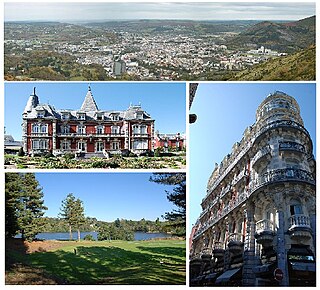
Lourdes is a market town situated in the Pyrenees. It is part of the Hautes-Pyrénées department in the Occitanie region in southwestern France. Prior to the mid-19th century, the town was best known for its Château fort, a fortified castle that rises up from a rocky escarpment at its center.
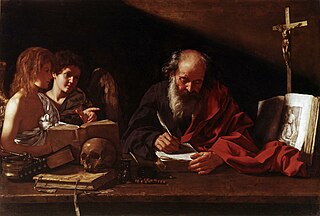
A hermit, also known as an eremite or solitary, is a person who lives in seclusion. Eremitism plays a role in a variety of religions.
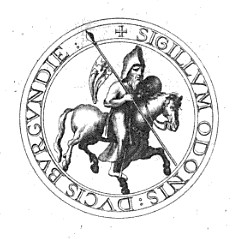
Odo I, also known as Eudes, surnamed Borel and called the Red, was duke of Burgundy between 1079 and 1102. Odo was the second son of Henry of Burgundy and grandson of Robert I. He became the duke following the abdication of his older brother, Hugh I, who retired to become a Benedictine monk at Cluny.

Charbel Makhlouf, O.L.M., born Youssef Antoun Makhlouf and venerated as Saint Charbel, was a Maronite monk and priest from Lebanon. During his life, he obtained a wide reputation for holiness, and for his ability to unite Christians, Muslims and Druze.
Hugo von Trimberg was a German didactic author of the Middle Ages.

Consecrated life is a state of life in the Catholic Church lived by those faithful who are called to follow Jesus Christ in a more exacting way. It includes those in institutes of consecrated life, societies of apostolic life, as well as those living as hermits or consecrated virgins/widows.

Benedict the Moor was a Sicilian Franciscan friar. Born of enslaved Africans in San Fratello, he was freed at birth and became known for his charity.

Robert of Newminster was a priest, abbot, and a saint of the Catholic Church. He was born in Gargrave in Yorkshire, England. He was one of the monks who founded Fountains Abbey and is named from the abbey he founded in Morpeth, Northumberland.
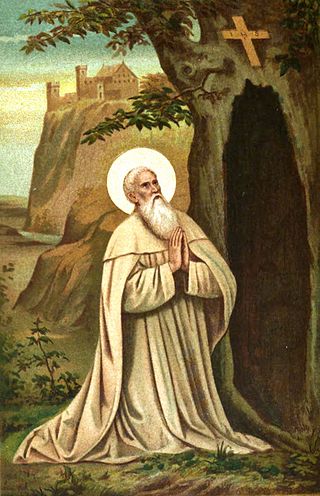
Gerlach was a 12th-century Dutch hermit. His cult is centered at Houthem near Valkenburg in the south of the province of Limburg.

The House of Andechs was a feudal line of German princes in the 12th and 13th centuries. The counts of Dießen-Andechs obtained territories in northern Dalmatia on the Adriatic seacoast, where they became Margraves of Istria and ultimately dukes of a short-lived imperial state named Merania from 1180 to 1248. They were also self-styled lords of Carniola.

Abraham Kidunaia was a Syriac Christian hermit and priest. He is venerated as a saint in Catholicism, Eastern Orthodoxy and Oriental Orthodoxy.

The Lourdes apparitions are several Marian apparitions reported in 1858 by Bernadette Soubirous, the 14-year-old daughter of a miller, in the town of Lourdes in Southern France.

Becherbach is an Ortsgemeinde – a municipality belonging to a Verbandsgemeinde, a kind of collective municipality – in the Bad Kreuznach district in Rhineland-Palatinate, Germany. It belongs to the Verbandsgemeinde of Meisenheim, whose seat is in the like-named town. Becherbach should not be confused with Becherbach bei Kirn, which lies in the same district.

Arc-sur-Tille is a commune in the Côte-d'Or department in the Bourgogne-Franche-Comté region of eastern France.

Michaelsberg Abbey or Michelsberg Abbey, also St. Michael's Abbey, Bamberg is a former Benedictine monastery in Bamberg in Bavaria, Germany. After its dissolution in 1803 the buildings were used for the almshouse Vereinigtes Katharinen- und Elisabethen-Spital, which is still there as a retirement home. The former abbey church remains in use as the Michaelskirche.
Baradates was a hermit who lived in the Diocese of Cyrrhus in Syria, and whose bishop, Theodoret, called him "the admirable Baradates."
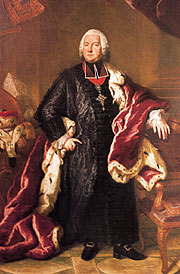
Adam Friedrich Graf von Seinsheim (1708–1779) was the Prince-Bishop of Würzburg from 1755 to 1779 and Prince-Bishop of Bamberg from 1757 to 1779.

Gunther was a German nobleman and prelate of the Holy Roman Empire. He served as Chancellor of Italy from 1054 until 1057 and as Bishop of Bamberg from 1057 until his death. He was the leader of the Great German Pilgrimage of 1064–65, on which he died.























